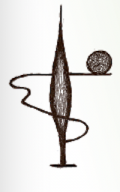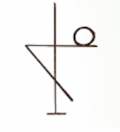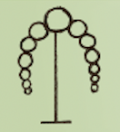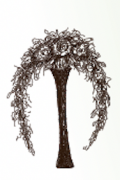Articles & Step By Step Tutorials
Learn new design styles and discover new techniques with these articles from Floral Focus magazines, and step by step tutorials.
Traditional and Contemporary Designing
So what is the difference?
by Lorraine Usher (in consultation with Margaret Ashley). Illustrations by Dorothy Turner
Traditional Floral Designs:
These are styles that originated in the post-war era and are still in use today.
Characteristics include geometric forms, a well-defined centre of interest, transitional plant material and all lines radiating from a central point.
There is gradation of size, form and colour with little space within the design.
Traditional designs can be line, line-mass or mass.

Contemporary Floral Designs:
Belonging to the present day. Refer to the "FASNZ Styles of Design and Techniques" handbook for examples.
Freeform and Abstract Designs come under Contemporary designing but both have distinctive characteristics and are not included in the comparison given below. Many Contemporary Designs are achieved by incorporating specific techniques e.g. Binding, Bundling, Clamping, Tufting, Tying, Grids, Plaiting, Tatami Weaving, Weaving etc.
Many of these techniques, which are constantly evolving, are used to change the shape and form of plant material to create Contemporary Designs whereas on occasions a certain manner of placement of plant material employed will achieve different styles e.g Sculptured Design, Pavé, Biedermeier, Mobile, Stabile and European Influence Design, Modern Mass etc.
The manner of placement of plant material may dictate the style or the style may dictate the placement of the plant material. Pre-prepared components may be included if the schedule allows. These are often crafted using the above techniques or embellishments.

Lines:
Traditional Floral Designs follow geometric line or form based on the sphere, cylinder or cone, whereas Contemporary Floral Designs have fewer geometric shapes used. Plant material is chosen for sculptural, rhythmic,textural and colour qualities and may dictate the line.

Outline Shape:
Traditional Designs may be asymmetrical or symmetrical with clear outlines, whereas Contemporary Designs may be any shape, sometimes symmetrical, however they are more often asymmetrical. Exaggerated height and width may be used.

Balance:
Traditional Design is often static, whereas with Contemporary Design, all forms of balance may be used - symmetrical, asymmetrical, dynamic and counter balance.

Plant Material: is used in Traditional Designs in its natural growth pattern and is not manipulated or distorted. Several varieties of plant material are used in one design, whereas with Contemporary Designs, manipulation of plant material is permitted. Bold shapes, strong lines and interesting textures are chosen.
Techniques may be used (refer to "Flair" and "FASNZ Styles of Design and Techniques") Contrast is emphasised, and there is more grouping of materials. Other components may be introduced. Plant material is used with restraint, often confined to 3 or 4 varieties and combinations may be unusual.
Transitional Plant Material is used in Traditional designing to fill spaces, link line material to the centre of interest, blend colour combinations and bridge contrasts in size of materials used, whereas Transitional Plant Material may be included in Contemporary work, but used in a different manner e.g. grouped, tufted etc. where it may lose its original identity.
Space: Traditional designing has a limited use of space within the design, whereas with Contemporary Design, space is generally a very important feature, often used within the design to enhance beauty of for and to contribute to balance and rhythm.
Centre of Interest: In Traditional Design a well defined, strong focal area is used just above the rim of the container. All plant material radiates from that area, whereas with Contemporary Design, there may be more than one centre of interest or pause point. Radiation may or may not be used from each centre of interest.

Radiation:
Lines in Traditional Design should not cross but radiate from a central point, whereas less radiation is used in Contemporary Design and lines may cross, be angular, bent or broken.

Containers:
Traditional vases, urns, jugs, traditional baskets, candlesticks, simple bowls, stemmed compotes are used; containers can be very utilitarian, whereas the container in contemporary work may be any suitable container or vessel, or a container may not be required at all.

Rhythm:
Traditional Design has smooth and uninterrupted rhythm. Gradual rhythm is achieved by placement of material by gradation, variation, radiation and repetition of colour, size, shape etc. whereas with Contemporary Design, rhythm may be gently flowing or may be abrupt and dynamic. Motion and rest sustain interest in a design. The eye is activated by imagination and will leap a space and follow a line.
Colour: With Traditional Design the colour rhythm is gradual and orderly. Colour is varied and harmonious, blended or contrasting, whereas there are no boundaries with Contemporary colour; there may be strong contrasts, dramatic, bold and bright or subtle blends.
Contrast: With Traditional Design there are often subtle contrasts in colour. form and texture, whereas with Contemporary design, contrasts may be strong or subtle.
Categories
- Step By Step Tutorials
- Colour Tutorials
- Techniques Tutorials
- Innovative Design Tutorials
- Styles Tutorials







